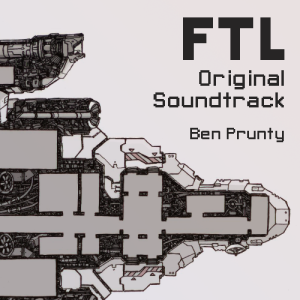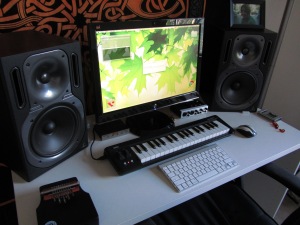 I get a lot of people asking me what tools I used to make the FTL soundtrack. I started answering them individually, but I think a blog post would be more efficient and useful to everyone. So here goes!
I get a lot of people asking me what tools I used to make the FTL soundtrack. I started answering them individually, but I think a blog post would be more efficient and useful to everyone. So here goes!
I have a Macbook Pro that’s the center of my setup. I record everything into Cubase, my DAW of choice. There are many quality DAWs out there. I hear Reason and FL Studio are good too. I originally purchased Cubase because ten years ago, when I knew nothing about music production, I asked Jesper Kyd what he used and Cubase was his answer.
Now I keep using it because I’ve had it for years and I’m good at it. This is important: the best tools are the ones you can use to get your work done efficiently. Most DAWs do pretty much the same thing. Choose one that seems the most interesting and then stick with it.
Cubase is just the workstation, the thing that lets me arrange a bunch of different sounds together into something interesting. What about the sounds themselves?
The Software
1. Native Instruments – These guys are incredible. They make a plethora of excellent software instruments. For $560 you can get a bundle of all of their best software. The huge amount of stuff you get for that money is ridiculous. Synthesizers, drum kits, samplers, even a pretty decent full orchestra library. Seriously, it’s nuts. It could keep you occupied for years. Most of the chiptunes-esque sounds in FTL came from Soundschool Analog, a dead-simple synthesizer in Reaktor, which is included in the Komplete bundle.
2. Plogue’s Chipsounds – This is an awesome old-game-system sound chip emulator. It covers just about any hardware you can think of, and costs about 80 bucks. I didn’t use this as much as Soundschool Analog, ironically, but it’s still incredibly convenient if you want to get started with chiptunes.

3. Heavyocity’s Evolve – This thing has some powerful, cinematic sounds, and they’re really fun to use. Wondering how I got all those industrial drums for Void and Deepspace? Much of it came from this collection. There are some fantastic drum kits here.
4. A bunch of discontinued Kore sound libraries – Kore is a neat library organizational tool that allows you to graft any number of different sounds together from different libraries to make new sounds. There were a bunch of cool, creative libraries made specifically for Kore as well. My other source of industrial sounds, like the beating drums in the background of Cosmos Battle, or much of Void, came from a Kore drum kit library called True Strike Tension. Many of the deeper textures and weirder sounds, like from Debris and Wasteland, came from Jeremiah Savage’s Sonic Fiction. A lot of the effects used to smooth out the basic synths came from effects library Deep Transformations. Sadly, all of these, including Kore itself, have been discontinued.
The Hardware
Computer – MacBook Pro – I got this thinking it would be cool to have a portable workstation. Now I realize I work better at home. The next upgrade will be for a desktop machine. The MacBook works great though. Maybe upgrade the memory if you can.
Audio interface – Native Instruments’ Komplete Audio 6 – I used to have a way more complicated and expensive device, but it was awful and eventually broke. This thing is (relatively) cheap and works perfectly.
Audio
- Behringer Truth 2031a (pair) – These sound awesome, and I see no reason to upgrade. They’re self-powering, so you don’t need to get an amp.
- Sennheiser HD280 Pro headphones – I’ve had these for 7 years and I love them. Some people have told me that these feel too tight on their head, but I haven’t had a problem.
- Klipsch IMAGE S4 In-Ear headphones – For whenever I do happen to be working remotely, these work really nicely. The bass is a little heavy though, so make sure you don’t do a final mix with these.
Recording
- Zoom H4n Handy portable recorder – Oh man, is this thing ever awesome. The screams of dying crew members were recorded on this thing in a closet. Sounds great, has stereo microphones, uses AA batteries, and it records directly to WAV instead of some dumbass proprietary format. Also has 2 inputs for fancier microphones if you like. If you’re a budding sound effects guy, this could be your best purchase.
- AKG Perception 200 – Sounds crisp, feels solid. Versatile. Get a 20-foot microphone cable too.
As for what kind of screen to use, just get the biggest damn monitor you can afford. Also get a good chair. If you have any specific questions, just send me a message on twitter (@benprunty) or shoot me an email. I sincerely hope this helps you in your musical endeavors. Send me your music!